Jane
Ingram Allen
Made In Taiwan
Taitung County
May 30 – June 11, 2005

Host Organization: Bureau of Cultural Affairs
Taitung County Government, Taitung Railway Art Village
No.25 Nan-Ching Road
Taitung, Taiwan 950 Republic of China
Contact Person: Christina Tang, Yu-yen Liu
Telephone: 886-89-320378 ext 263 or 886-89-353543
FAX: 886-89-340804
Email: sctang@mail.ccl.ttct.edu.tw
Web site: www.ccl.ttct.edu.tw
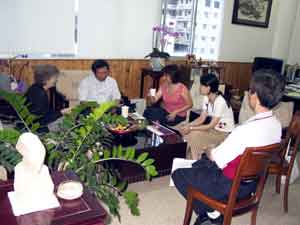

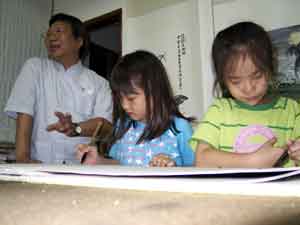
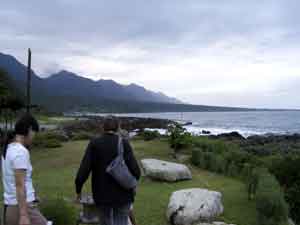 We
are now in Taitung and finding the area to be very beautiful. The people
here are a very good example of the Taiwanese, exceptionally friendly
and helpful. When we arrived at the airport, two of the staff from the
Taitung Railway Art Village met us. We visited the Taitung County Bureau
of Cultural Affairs and met Chief of the Arts Promotion Section Lee, Chi-Chung.
He is a calligrapher and signed one of his art works to give to us. He
will have it framed for us to take back with us. He then invited us to
dinner at a restaurant on the sea shore. Before we went to dinner, we
visited his studio. It is in a two-story seaside villa that has a huge
yard next to the ocean.This is a beautiful spot because you can see the
high mountains rising from the ocean. He asked Jane to do a small art
work using the Chinese ink and brushes. She did a palm like drawing with
the brush. It was after spending a couple of hours at his studio that
we went to the restaurant next door with several new friends from Taitung.
We had an excellent meal and enjoyed hearing the ocean break against the
rocks.
We
are now in Taitung and finding the area to be very beautiful. The people
here are a very good example of the Taiwanese, exceptionally friendly
and helpful. When we arrived at the airport, two of the staff from the
Taitung Railway Art Village met us. We visited the Taitung County Bureau
of Cultural Affairs and met Chief of the Arts Promotion Section Lee, Chi-Chung.
He is a calligrapher and signed one of his art works to give to us. He
will have it framed for us to take back with us. He then invited us to
dinner at a restaurant on the sea shore. Before we went to dinner, we
visited his studio. It is in a two-story seaside villa that has a huge
yard next to the ocean.This is a beautiful spot because you can see the
high mountains rising from the ocean. He asked Jane to do a small art
work using the Chinese ink and brushes. She did a palm like drawing with
the brush. It was after spending a couple of hours at his studio that
we went to the restaurant next door with several new friends from Taitung.
We had an excellent meal and enjoyed hearing the ocean break against the
rocks.

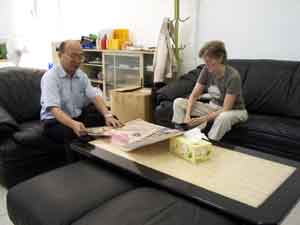
 The
next day we installed the exhibit at the gallery. It, like the studio
space, is a former railway warehouses next to the tracks. Unlike Chiayi,
the trains do not come through here any more. The station has been moved
8 kilometers from downtown. The gallery is a nice space, and it was easy
to hang the work. We worked with some of the maintenance staff to adjust
the lighting. We also went to the Taitung District Agricultural Research
and Extension Station to pick plants. We had some very generous help from
Kou-Jong Lin, Horticulturist and Head of the Agricultural Extension Station.
We picked a number of plants that we would use to make paper. It was also
there that we had a visit from a friend from San Zhi, Stella. She was
with two people from the area. One was named Nabou, and he is from the
Bunum Aboriginal tribe, and the other was Tommie Williamson, an American
film maker. Tommie is working with Nabou and the Bunum tribe to create
some documentary films and other educational programs. Tommie invited
us to visit Bunum and enjoy the hot springs. We decided that we needed
to install the exhibit so it was not possible to go this time. We did
complete the hanging of the exhibit by 7 PM and then went to dinner.
The
next day we installed the exhibit at the gallery. It, like the studio
space, is a former railway warehouses next to the tracks. Unlike Chiayi,
the trains do not come through here any more. The station has been moved
8 kilometers from downtown. The gallery is a nice space, and it was easy
to hang the work. We worked with some of the maintenance staff to adjust
the lighting. We also went to the Taitung District Agricultural Research
and Extension Station to pick plants. We had some very generous help from
Kou-Jong Lin, Horticulturist and Head of the Agricultural Extension Station.
We picked a number of plants that we would use to make paper. It was also
there that we had a visit from a friend from San Zhi, Stella. She was
with two people from the area. One was named Nabou, and he is from the
Bunum Aboriginal tribe, and the other was Tommie Williamson, an American
film maker. Tommie is working with Nabou and the Bunum tribe to create
some documentary films and other educational programs. Tommie invited
us to visit Bunum and enjoy the hot springs. We decided that we needed
to install the exhibit so it was not possible to go this time. We did
complete the hanging of the exhibit by 7 PM and then went to dinner.
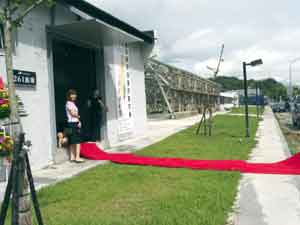

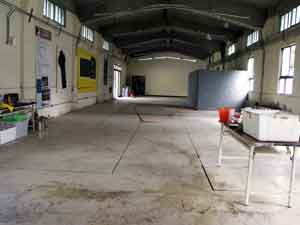
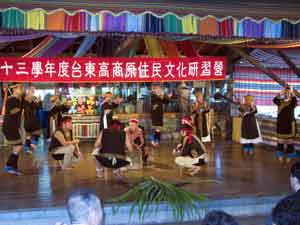 The
next day we began to work on the plants that we had picked and to set
up the studio workshop space. We also had the opening of the "Made
in Taiwan exhibition at the Taitung Railway Art Village. Many important
people were in attendance, including the Taitung County Magistrate.
We met with Tommie again, and he talked about the various projects that
he has doing in the Taitung area, one of which is to help children who
are at risk. We visitedt Bunum Village later that day and saw the traditional
dancing and singing program they give daily for the tourists. We
were also able to see the weaving studio and learn how they are doing
weaving now in Bunum village.
The
next day we began to work on the plants that we had picked and to set
up the studio workshop space. We also had the opening of the "Made
in Taiwan exhibition at the Taitung Railway Art Village. Many important
people were in attendance, including the Taitung County Magistrate.
We met with Tommie again, and he talked about the various projects that
he has doing in the Taitung area, one of which is to help children who
are at risk. We visitedt Bunum Village later that day and saw the traditional
dancing and singing program they give daily for the tourists. We
were also able to see the weaving studio and learn how they are doing
weaving now in Bunum village.

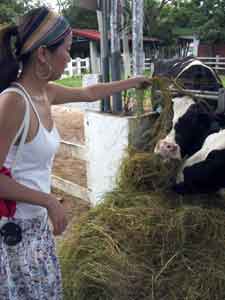
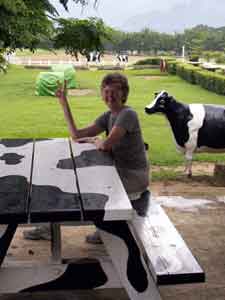 On
June 2, Jane continued to make paper with the local plants, but in the
afternoon we were able to travel around the Taitung area to see various
sites. We first went to some of the parks that are near the sea. There
are many walking trails and places for people to get together for family
gatherings. We then went to the Matsu Temple. This is the largest temple
in Taitung. It is exceptionally ornate with many carvings. One of the
most interesting items they had on display was a very large orange pumpkin.
It appeared that people had signed it. Outside we saw a very interesting
person who was wearing rag socks and a yellow jacket and protective helmet.He
was able to say a few words in English. We went from the temple to a dairy
farm. This is first dairy farm we have visited in Taiwan. It had over
1000 milking cows. They seemed to be well cared for, and we enjoyed feeding
some of them some grass. That night we had dinner at a Thai restaurant
that was very good. The owner normally runs a travel service but enjoys
cooking Thai food.
On
June 2, Jane continued to make paper with the local plants, but in the
afternoon we were able to travel around the Taitung area to see various
sites. We first went to some of the parks that are near the sea. There
are many walking trails and places for people to get together for family
gatherings. We then went to the Matsu Temple. This is the largest temple
in Taitung. It is exceptionally ornate with many carvings. One of the
most interesting items they had on display was a very large orange pumpkin.
It appeared that people had signed it. Outside we saw a very interesting
person who was wearing rag socks and a yellow jacket and protective helmet.He
was able to say a few words in English. We went from the temple to a dairy
farm. This is first dairy farm we have visited in Taiwan. It had over
1000 milking cows. They seemed to be well cared for, and we enjoyed feeding
some of them some grass. That night we had dinner at a Thai restaurant
that was very good. The owner normally runs a travel service but enjoys
cooking Thai food.
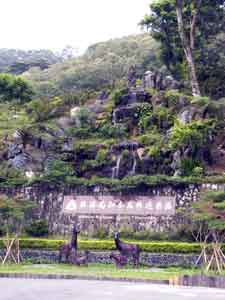

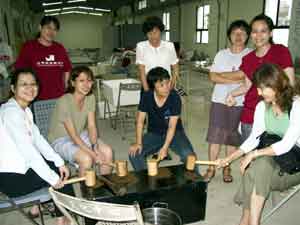 Early
the following day we went to the Chijbin Forest Recreation Center south
of Taitung City. It was very beautiful, and they had a plant Jane wanted
to use for papermaking. This was a variety of pandandus, and they
allowed us to take the dead leaves. The supervisor picked some of the
green leaves and gave that to us as well. We then went on to the Taimali
Forest Research Center in a nearby town and visited with the staff. The
Chief was in Kinmen but would return later in the week. We arranged to
return when the Chief would be there. We also looked at some plant books
and explained that we needed some additional local plant materials for
Jane's papermaking. We returned to the studio, and a group of teachers
came to the open studio program Jane presented. They got to see how paper
was made. They also visited the gallery. Jane continued to make
paper in preparation for creating her Taitung site map.
Early
the following day we went to the Chijbin Forest Recreation Center south
of Taitung City. It was very beautiful, and they had a plant Jane wanted
to use for papermaking. This was a variety of pandandus, and they
allowed us to take the dead leaves. The supervisor picked some of the
green leaves and gave that to us as well. We then went on to the Taimali
Forest Research Center in a nearby town and visited with the staff. The
Chief was in Kinmen but would return later in the week. We arranged to
return when the Chief would be there. We also looked at some plant books
and explained that we needed some additional local plant materials for
Jane's papermaking. We returned to the studio, and a group of teachers
came to the open studio program Jane presented. They got to see how paper
was made. They also visited the gallery. Jane continued to make
paper in preparation for creating her Taitung site map.
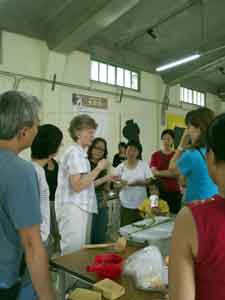
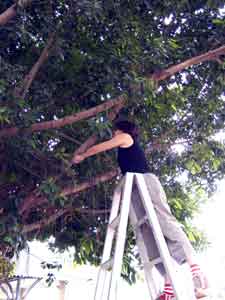
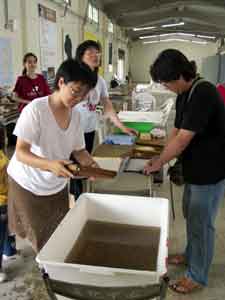
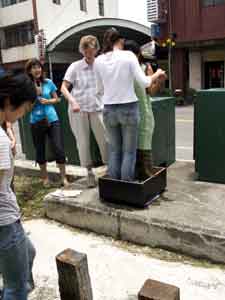 The
weekend was dedicated to the two-day pulbic workshop. Over 20 people attended
with most being teachers. As Jane has done in the past she opened the
workshop with introductions and a Power Point presentation on making paper
and how it can be used for art. The students then were shown how
to make paper using the western or single dip method. They each made a
sheet of paper that was put on felt and then pressed. Pressing is done
by placing the stack of paper on the ground and placing a board on top.
Usually, two or more people stand on the board and shift their weight
back and forth to press the water out of the paper. This is a very effective
method, and everyone has fun doing it. The students then placed the paper
on three dimensional objects such as trees, rocks and gratings. Following
lunch, students learned how to make paper using the Asian or multiple
dip method. Using this method it is possible to make very strong paper
that is very thin. They also learned they could put objects onto the paper
and make it more artistic. At the close of the day the students had made
many sheets of paper.
The
weekend was dedicated to the two-day pulbic workshop. Over 20 people attended
with most being teachers. As Jane has done in the past she opened the
workshop with introductions and a Power Point presentation on making paper
and how it can be used for art. The students then were shown how
to make paper using the western or single dip method. They each made a
sheet of paper that was put on felt and then pressed. Pressing is done
by placing the stack of paper on the ground and placing a board on top.
Usually, two or more people stand on the board and shift their weight
back and forth to press the water out of the paper. This is a very effective
method, and everyone has fun doing it. The students then placed the paper
on three dimensional objects such as trees, rocks and gratings. Following
lunch, students learned how to make paper using the Asian or multiple
dip method. Using this method it is possible to make very strong paper
that is very thin. They also learned they could put objects onto the paper
and make it more artistic. At the close of the day the students had made
many sheets of paper.
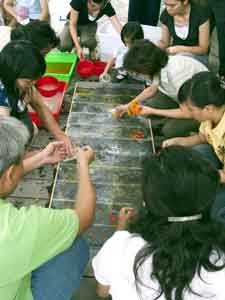

 The
second day of the workshop the students continued to make paper and just
before lunch they learned the pouring method. A large screen was placed
on the ground and the remaining pulp was used to pour onto the screen.
Items such as flowers, pictures and other found objects were added and
then covered with pulp. The work created by the students would be placed
out to dry and then be displayed in the gallery. Following lunch the students
took the dried paper that they had made the day before and began to create
artworks. Some of them did an exceptional job and made works that were
very creative. It appeared that everyone enjoyed the workshop and learned
quite a bit about papermaking art. Some of the students asked if Jane
would be interested in teaching a class in dyeing of paper pulp. She may
return to Taitung to teach again.
The
second day of the workshop the students continued to make paper and just
before lunch they learned the pouring method. A large screen was placed
on the ground and the remaining pulp was used to pour onto the screen.
Items such as flowers, pictures and other found objects were added and
then covered with pulp. The work created by the students would be placed
out to dry and then be displayed in the gallery. Following lunch the students
took the dried paper that they had made the day before and began to create
artworks. Some of them did an exceptional job and made works that were
very creative. It appeared that everyone enjoyed the workshop and learned
quite a bit about papermaking art. Some of the students asked if Jane
would be interested in teaching a class in dyeing of paper pulp. She may
return to Taitung to teach again.


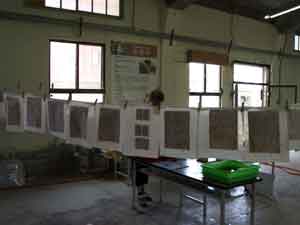 On
Monday, Jane had a visit from an architecture class from Tainan National
University of the Arts. They came to see Jane's work and to see the architectural
changes that had been done to the Railway Artist Village. They did have
a chance to make the western style of paper and do the human press. Following
their visit, Jane continued to work on getting her site map started. It
was getting very warm in the studio area, but Jane decided to prepare
her site map from there.
On
Monday, Jane had a visit from an architecture class from Tainan National
University of the Arts. They came to see Jane's work and to see the architectural
changes that had been done to the Railway Artist Village. They did have
a chance to make the western style of paper and do the human press. Following
their visit, Jane continued to work on getting her site map started. It
was getting very warm in the studio area, but Jane decided to prepare
her site map from there.

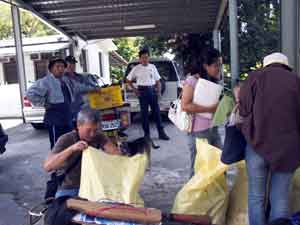
 The
following day we were taken to the Forestry Research Institute to visit
with the Chief who had returned from Kinmen. Unfortunately, he only had
a short time for the visit as he had a plane to catch to go to Taipei,
but we were able to collect many additional plants from the forest area
above the Center. Four workers went out to pick, and I followed later
to take pictures. The timing for this picking was unusual for us, as we
normally by this time in our two week schedule have completed all of the
picking, cooking and paper making for samples, and Jane is into making
her site map. Fortunately, we had some volunteers to help. One of
these was Ms Lee, a local artist, who came almost every day to help.
The
following day we were taken to the Forestry Research Institute to visit
with the Chief who had returned from Kinmen. Unfortunately, he only had
a short time for the visit as he had a plane to catch to go to Taipei,
but we were able to collect many additional plants from the forest area
above the Center. Four workers went out to pick, and I followed later
to take pictures. The timing for this picking was unusual for us, as we
normally by this time in our two week schedule have completed all of the
picking, cooking and paper making for samples, and Jane is into making
her site map. Fortunately, we had some volunteers to help. One of
these was Ms Lee, a local artist, who came almost every day to help.
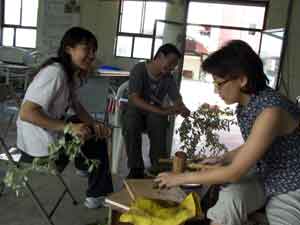 After
our visit to the Forestry Research Center, we had to get back to
After
our visit to the Forestry Research Center, we had to get back to  Taitung
as we had an appointment with the President of National Taitung University.
Dr. Gou, is a chemist and an educator. He is particularly interested in
how children learn science. This study is important for National Taitung
University as it has been only 3 years since the university was named
a national university. Prior to this, it was a normal or teacher's college.
Although they are expanding their programs, they still have a large focus
on teacher education. We talked at some length about what Jane was doing
and how in the future we would like to work with his University in various
capacities. We have been exceedingly honored to have met and gotten to
know a number of University Presidents in our travels around Taiwan. It
has helped us broaden our understanding of the educational system.
Taitung
as we had an appointment with the President of National Taitung University.
Dr. Gou, is a chemist and an educator. He is particularly interested in
how children learn science. This study is important for National Taitung
University as it has been only 3 years since the university was named
a national university. Prior to this, it was a normal or teacher's college.
Although they are expanding their programs, they still have a large focus
on teacher education. We talked at some length about what Jane was doing
and how in the future we would like to work with his University in various
capacities. We have been exceedingly honored to have met and gotten to
know a number of University Presidents in our travels around Taiwan. It
has helped us broaden our understanding of the educational system.
This was a busy day. Following lunch we went North along the coast to
see some of the sites. One that seems to fascinate many people is the
"water that runs up hill". It is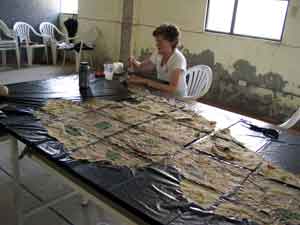 an optical illusion but fascinating to observe the people looking and
trying to understand what they are seeing. We then went to visit
a sculpture studio and museum. It was the BooSong Art & Design Studio
and The Adolan Museum of Brown-sugar and Arts. Brian Tsau, the president
showed us around the facility and introduced us to one of the artists/curator.
Their museum has some exhibits about the Amis tribe, one of six aboriginal
tribes living in the Taitung area. The museum also includes a sugar mill
that is no longer in operation, but it has not been dismantled. It retains
all of its equipment in the original colors. It would be a place that
I would like to return and do a photo essay.
an optical illusion but fascinating to observe the people looking and
trying to understand what they are seeing. We then went to visit
a sculpture studio and museum. It was the BooSong Art & Design Studio
and The Adolan Museum of Brown-sugar and Arts. Brian Tsau, the president
showed us around the facility and introduced us to one of the artists/curator.
Their museum has some exhibits about the Amis tribe, one of six aboriginal
tribes living in the Taitung area. The museum also includes a sugar mill
that is no longer in operation, but it has not been dismantled. It retains
all of its equipment in the original colors. It would be a place that
I would like to return and do a photo essay.
Now the pressure was on Jane to complete the site map for Taitung. The exhibit would open Saturday with many distinguished visitors expected to attend. We also had all of these new plants that had been picked the day before at the Forestry Research Center to get completed. Fortunately, we had a number of volunteers that helped prepare the bark and leaves for cooking. Jane continued to work on her site map.
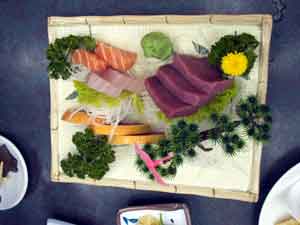
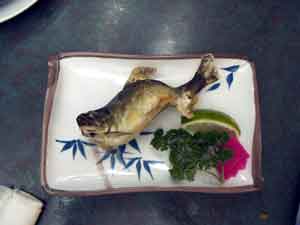 That
evening we went out with Tommie Williams to a Japanese restaurant. We
ordered a variety of items based on pictures in the menu. Many we were
familiar with, but there were a few that surprised us. One was a fish
that by all appearances was large - in fact you had two choices - small
and large. Well, with three of us, well actually two as Tommie does not
eat fish, I ordered the large. The picture does not do justice to our
surprise when this tortured looking small fish arrived at our table. Unfortunately,
it was not very tasty, and we gave it a suitable burial by covering it
with one of the few napkins that we had available. When the waitress returned
to the table and noted the covered fish, she got the message bowed her
head and said Amen over the fish. Needless to say this was so out of place
that it sent us into gales of laughter. It was a fun evening and one that
would be impossible to repeat.
That
evening we went out with Tommie Williams to a Japanese restaurant. We
ordered a variety of items based on pictures in the menu. Many we were
familiar with, but there were a few that surprised us. One was a fish
that by all appearances was large - in fact you had two choices - small
and large. Well, with three of us, well actually two as Tommie does not
eat fish, I ordered the large. The picture does not do justice to our
surprise when this tortured looking small fish arrived at our table. Unfortunately,
it was not very tasty, and we gave it a suitable burial by covering it
with one of the few napkins that we had available. When the waitress returned
to the table and noted the covered fish, she got the message bowed her
head and said Amen over the fish. Needless to say this was so out of place
that it sent us into gales of laughter. It was a fun evening and one that
would be impossible to repeat.
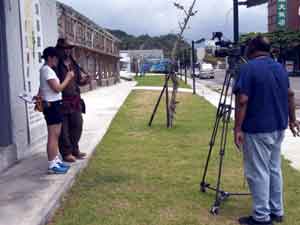
 The
next morning Jane continued to work on her site map. Tommie arrived with
a film crew to shoot Jane's work in the gallery. He also asked that she
continue to work with the volunteers as they prepared the plants, cooking
and beating the ones that had been cooked the day before. Once he had
completed the filming he will take it back to the studio and do the editing.
We are not sure how this film will be used. Maybe someday will get a chance
to see it in its completed form.
The
next morning Jane continued to work on her site map. Tommie arrived with
a film crew to shoot Jane's work in the gallery. He also asked that she
continue to work with the volunteers as they prepared the plants, cooking
and beating the ones that had been cooked the day before. Once he had
completed the filming he will take it back to the studio and do the editing.
We are not sure how this film will be used. Maybe someday will get a chance
to see it in its completed form.
Jane also had a scheduled interview to do at the local Public Education Radio station in Taitung. This station is one of many that are located throughout Taiwan. It is unusual for us to visit a radio station to do an interview. It is usually done on site or by phoning the station. The interview went well and later Ms. Hu sent Jane a copy of the interview. Jane then returned to the studio to finish her site map in preparation for the opening in two days.
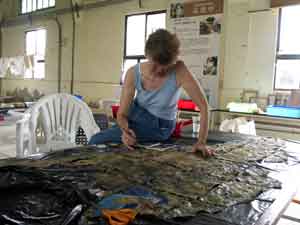 In
fact all of the next day was spent working on the site map. As is becoming
characteristic of Jane's site maps, this one is based on an image of the
county's shape with one side featuring the culture and the other side
being about the plants and the environmental aspects of the county. She
completed the map by the end of the day. We went out to eat and then began
the process of washing and packing.
In
fact all of the next day was spent working on the site map. As is becoming
characteristic of Jane's site maps, this one is based on an image of the
county's shape with one side featuring the culture and the other side
being about the plants and the environmental aspects of the county. She
completed the map by the end of the day. We went out to eat and then began
the process of washing and packing.
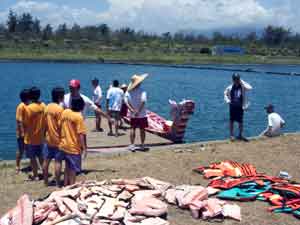
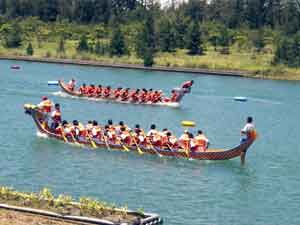

 Our
last full day in Taitung would be an interesting one. The exhibit would
take place at 2:00 PM. Prior to that we needed to hang the map and the
community work that had been done. Once that was completed, we had a special
treat to visit the Dragon Boat races. These are held on an artificial
lake that appears by its rectangular design to be built specifically for
these races. The Dragon Boats as you can see from the photos are highly
decorative and with a little bit of imagination they appear to be dragons
racing on the surface of the water. Teams are made up from various locations.
We watched the National Taitung University Team compete with the local
police team. The police won. There were lots of booths selling food and
souvenirs. It was fun to watch but extremely hot so we did not stay long.
From there we went to a nice seafood restaurant translated into English
text as Mayo Seafood. We thought that this was an interesting play on
words as the word, "Mayo" means "have not." We seemed
to be the only ones that saw any humor in this interpretation as we were
told that this is not the same character in Chinese as the one for "Mayo"
but that it is a family name. I guess it loses something in translation.
We returned for Jane's closing reception in Taitung and display of the
Taitung Site Map and community works. Overall, it was an enjoyable
and interesting day.
Our
last full day in Taitung would be an interesting one. The exhibit would
take place at 2:00 PM. Prior to that we needed to hang the map and the
community work that had been done. Once that was completed, we had a special
treat to visit the Dragon Boat races. These are held on an artificial
lake that appears by its rectangular design to be built specifically for
these races. The Dragon Boats as you can see from the photos are highly
decorative and with a little bit of imagination they appear to be dragons
racing on the surface of the water. Teams are made up from various locations.
We watched the National Taitung University Team compete with the local
police team. The police won. There were lots of booths selling food and
souvenirs. It was fun to watch but extremely hot so we did not stay long.
From there we went to a nice seafood restaurant translated into English
text as Mayo Seafood. We thought that this was an interesting play on
words as the word, "Mayo" means "have not." We seemed
to be the only ones that saw any humor in this interpretation as we were
told that this is not the same character in Chinese as the one for "Mayo"
but that it is a family name. I guess it loses something in translation.
We returned for Jane's closing reception in Taitung and display of the
Taitung Site Map and community works. Overall, it was an enjoyable
and interesting day.
Overall, we found Taitung to be a very topical and relaxed place. Everything moved a little slower than we found in the rest of Taiwan. It probably had a lot to do with the heat. The people are very enthusiastic and love Taitung. As with all of the other places in Taiwan, we were greeted warmly and enthusiastically. We hope we can return to Taitung in the near future.
Return to Made In Taiwan home page
(updated on June 27, 2005 )
For more information on Jane, click on one of the icons below







